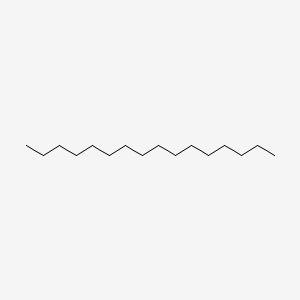| MeSH term | MeSH ID | Detail |
|---|---|---|
| Lupus Erythematosus, Systemic | D008180 | 43 associated lipids |
| Body Weight | D001835 | 333 associated lipids |
| Coronary Disease | D003327 | 70 associated lipids |
| Peritonitis | D010538 | 38 associated lipids |
| Hyperplasia | D006965 | 34 associated lipids |
| Glomerulonephritis | D005921 | 35 associated lipids |
| Encephalomyelitis, Autoimmune, Experimental | D004681 | 26 associated lipids |
| Keratosis | D007642 | 9 associated lipids |
| Serratia Infections | D016868 | 2 associated lipids |
Hexadecane
Hexadecane is a lipid of Fatty Acyls (FA) class. The involved functions are known as Analyte. The related lipids are Fatty Acids and palmitoleic acid.
Cross Reference
Introduction
To understand associated biological information of Hexadecane, we collected biological information of abnormalities, associated pathways, cellular/molecular locations, biological functions, related genes/proteins, lipids and common seen animal/experimental models with organized paragraphs from literatures.
What diseases are associated with Hexadecane?
There are no associated biomedical information in the current reference collection.
Possible diseases from mapped MeSH terms on references
We collected disease MeSH terms mapped to the references associated with Hexadecane
PubChem Associated disorders and diseases
What pathways are associated with Hexadecane
There are no associated biomedical information in the current reference collection.
PubChem Biomolecular Interactions and Pathways
Link to PubChem Biomolecular Interactions and PathwaysWhat cellular locations are associated with Hexadecane?
There are no associated biomedical information in the current reference collection.
What functions are associated with Hexadecane?
Related references are published most in these journals:
| Function | Cross reference | Weighted score | Related literatures |
|---|
What lipids are associated with Hexadecane?
Related references are published most in these journals:
| Lipid concept | Cross reference | Weighted score | Related literatures |
|---|
What genes are associated with Hexadecane?
There are no associated biomedical information in the current reference collection.
What common seen animal models are associated with Hexadecane?
There are no associated biomedical information in the current reference collection.
NCBI Entrez Crosslinks
All references with Hexadecane
Download all related citations| Authors | Title | Published | Journal | PubMed Link |
|---|---|---|---|---|
| Greene RT et al. | Surface hydrophobicity of Staphylococcus intermedius and Staphylococcus hyicus. | 1992 | Res. Vet. Sci. | pmid:1553442 |
| Liu YC et al. | Molecular characterization of the alkB gene in the thermophilic Geobacillus sp. strain MH-1. | 2009 | Res. Microbiol. | pmid:19733653 |
| Vaysse PJ et al. | Proteomic analysis of Marinobacter hydrocarbonoclasticus SP17 biofilm formation at the alkane-water interface reveals novel proteins and cellular processes involved in hexadecane assimilation. | 2009 | Res. Microbiol. | pmid:19786096 |
| Klein B et al. | Cytoplasmic wax ester accumulation during biofilm-driven substrate assimilation at the alkane--water interface by Marinobacter hydrocarbonoclasticus SP17. | 2008 | Res. Microbiol. | pmid:18191384 |
| Kelly SD et al. | Deuterium/hydrogen isotope ratio measurement of water and organic samples by continuous-flow isotope ratio mass spectrometry using chromium as the reducing agent in an elemental analyser. | 2001 | Rapid Commun. Mass Spectrom. | pmid:11466785 |
| Redpath JL and Patterson LK | Radiosensitization of Serratia marcescens by cetylpyridinium chloride. Evidence for membrane-associated events. | 1976 | Radiology | pmid:766063 |
| Falconer WE et al. | Effects of dose, dose rate, and trace impurities on n-hexadecane radiolysis. | 1971 | Radiat. Res. | pmid:5559385 |
| Bell SG et al. | Engineering the CYP101 system for in vivo oxidation of unnatural substrates. | 2001 | Protein Eng. | pmid:11739899 |
| Hiran T et al. | Evidence for the involvement of the NADPH oxidase enzyme complex in the optimal accumulation of Platelet-activating factor in the human cell line PLB-985. | 2001 | Prostaglandins Other Lipid Mediat. | pmid:11785782 |
| Beck FW et al. | Improvements for consistently inducing experimental allergic encephalomyelitis (EAE) in rats: I. without using mycobacterium. II. inoculating encephalitogen into the ear. | 1976 | Proc. Soc. Exp. Biol. Med. | pmid:815915 |
